
Unveiling the Hidden Costs of Forgotten 401(k) Accounts
In a troubling trend, an analysis by Capitalize reveals that an astonishing 31.9 million 401(k) accounts have been left behind, collectively holding a staggering $2.1 trillion in assets. This sharp increase of about 30% since the last report in mid-2023 poses a severe risk to American workers’ financial future.
Why Are So Many 401(k)s Forgotten?
The primary reasons for this widespread amnesia about retirement savings stem from job changes and subsequent administrative burdens. Many workers find themselves switching employers frequently — a situation compounded by layoffs, especially within federal sectors where nearly three million Thrift Savings Plan accounts may be abandoned by the end of 2025.
Increased participation in retirement plans, thanks to legislative changes like the Secure 2.0 Act, means more people have 401(k) accounts, but unfortunately, knowing how to manage them during job transitions often feels overwhelming. The manual process of rolling over a 401(k) into a new account can lead to procrastination or complete abandonment, resulting in retirees missing out on potential savings.
The Financial Fallout of Leaving 401(k)s Behind
On average, forgotten 401(k) accounts now hold $66,691, an increase from $56,616 in early 2023. This seemingly innocuous oversight can translate into dire financial consequences. Lack of active management can result in excessive fees and unfavorable asset allocation, potentially costing individuals more than $500,000 over their careers. The stark contrast between a well-managed account with a low fee structure can make a massive difference in retirement savings through compounding returns.
Making Smart Financial Moves with 401(k) Plans
If you're among those risking big losses by forgetting about your 401(k), there are proactive steps to take. Here’s a practical guide:
- Rollover Into Your New Employer's 401(k): If you start a new job with a 401(k) plan, consider rolling over your old account. This seamlessly consolidates your retirement savings.
- Transfer to an IRA: Rolling over your 401(k) to an IRA provides greater flexibility and control over your investments. This is particularly beneficial if you want to diversify your portfolio further.
- Beware of Cashing Out: While cashing out might seem appealing, especially for those on the verge of retirement, be mindful of taxes and penalties that could significantly reduce your savings.
- Leave It Where It Is: Sometimes it might be beneficial to keep your 401(k) where it is. Compare its fees and investment performance with potential options elsewhere.
Conclusion: Don't Leave Money on the Table
Understanding your options regarding forgotten 401(k) accounts is crucial for ensuring a stable financial future. Taking the time to consolidate and manage these accounts reduces the risk of losing track of funds that could significantly enhance retirement savings. By integrating proactive financial management strategies into your routine, you can avoid the pitfalls of forgotten accounts. Don’t hesitate — make the right move with your retirement savings today.
Want to safeguard your financial future? Start taking control of your 401(k) savings today and maximize your retirement potential!
 Add Row
Add Row  Add
Add 




Write A Comment